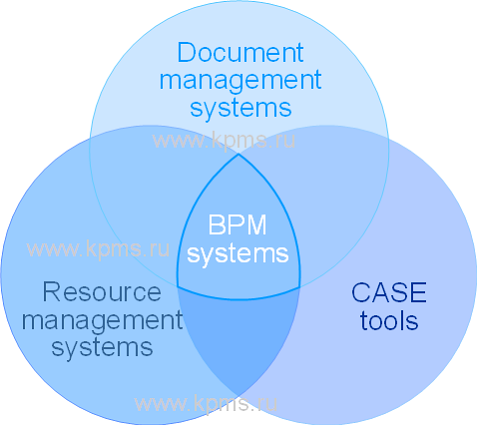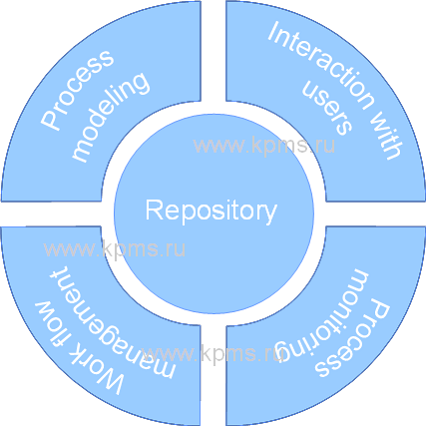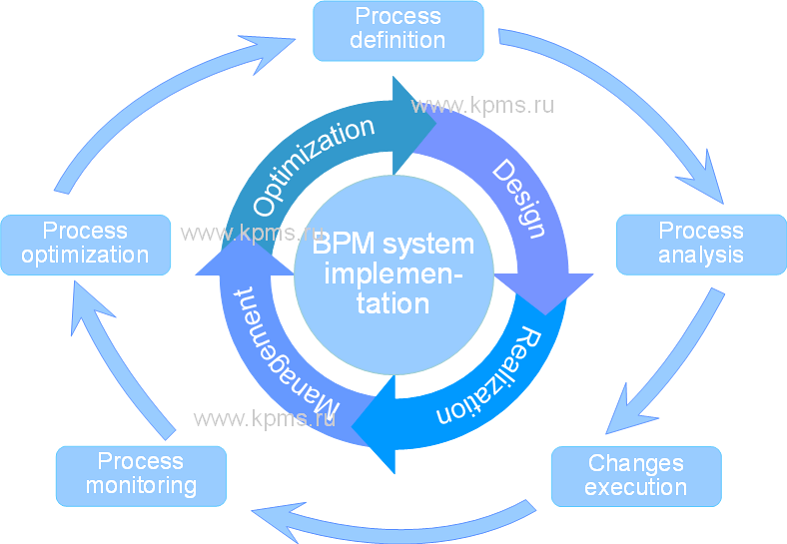BPM (Business Process Management) system is a software products class that helps manage an organization's business processes. It becomes possible to identify processes in the company, make their graphical schemes, perform management, analysis and further improvement of business processes due to the use of BPM systems.
BPM systems
The main purpose of BPM systems is to increase the efficiency of the organization, reduce the cost of products or services provided and improve the management system. This class of software was created in a such way that it was possible to quickly identify weaknesses in the processes and divisions of the company that reduce overall work efficiency.
BPM systems are easier to learn and faster bring benefits from implementation in contrast other corporate information systems that use a process approach (ERP, CRM, OLAP systems, DocFlow). They give managers an easier way to control the situation in the organization, line staff - a clear distribution of responsibility and effective management of their working time, consumers - a faster and better product or service.
BPM systems are at the junction of three classes of corporate software among the information systems that provide automation and management of business processes.
These classes include:

- Documentation management systems that make it possible to control the movement of documents according to specified rules. These systems automate the documentation movement;
- Resource management systems, such as ERP, CRM systems that allow you to manage and control material and human resources. These systems automate resource management;
- CASE tools, such as ARIS, BPwin, ERwin, Rational Rose, which allow you to model and analyze the processes of the organization. These systems automate the modeling and creation of processes.
The functionality of BPM systems is expanding every year. They have absorbed the advantages of many "traditional" corporate business support systems. BPM systems include some of the tools of these systems. BPM systems have the ability to integrate with corporate management systems, which greatly simplifies their integration into the organization's IT infrastructure.
Differences of the BPM systems
BPM systems are aimed at automating the company's unique processes in comparison with other automation systems. Corporate management systems, such as ERP systems, as a rule, already contain built-in functionality (reference models), which, due to options, is configured for the organization's process. The process itself has to be significantly changed for the specified functionality of the ERP system at the same time. BPM systems allow you to automate a unique process of the organization without given reference model.
Document management systems provide documentation management by creating document flow diagrams. These schemes, as a rule, are typical algorithms for processing documentation, as well as its storage. The flow patterns of documents become disconnected from the processes in which documents arise and participate at the same time. The BPM system modules create documentation management flows based on a graphical representation of the process. This makes it possible to keep documents connected to the organization's processes.
One of the BPM systems strengths is the ability to integrate with other software products. This significantly increases the flexibility of the created business process models. Most CASE tools are "monolithic" software products focused on solving a limited set of tasks. The business process models created in these CASE tools have limited integration capabilities. Service-Oriented Architecture (SOA) is used in BPM systems. It allows you to easily integrate business process models into various applications.
BPM System Structure
The flow of work, information and interactions between systems and people involved in the process are managed due to the BPM system. The structure of a BPM system includes several software components that allow you to manage all these interactions as a rule.

In general, the structure of the BPM system contains software components for joint modeling of business processes, tools for creating and managing business rules, and modules that allow you to create an IT infrastructure and integrate it into an existing business process. The structure of the BPM system includes a workflow management tool and a repository for executing and storing business process models. Another important element of the BPM system structure is the analysis and reporting module, which allows users to monitor business processes.
The main software modules included in the BPM system are as follows:
- Graphical modeling module. This tool is designed for graphical modeling of the process. The analyst can present the process in terms of work flow, business rules and information flow with its help;
- Dynamic modeling module. BPM systems allow you to present a business process model in dynamics with this tool. Problematic areas of processes and resource constraints are identified due to this, which makes it possible to make adjustments to the process at the modeling stage;
- Application development module. This module provides the developer with the necessary tools to create a user interface, various dialog forms and integrate the BPM system with business applications and information systems;
- A module for managing work flows and business rules. This module implements the management of work flows, information flows and documents, as well as controls the execution of specified business rules. Tasks are formed for the personnel involved in the process and business rules are formed for information systems interconnected with the BPM system in this module.
- Process interface module. Users can view assigned tasks, manage the priority of tasks and perform them due to this module;
- Process management module. This module is necessary for monitoring the process. It allows you to get process indicators, analyze them, and generate the necessary reports. Monitoring can be carried out according to various business processes parameters. You can quickly make adjustments to the processes in the BPM system based on these parameters;
- The BPM system management module. This module is a system administrator tool. It is used to configure software tools, assign access rights, monitor the operation of hardware, etc.
Modules may have different names (depending on the system developer) in different BPM systems.
BPM system Implementation
The implementation of the BPM system has the same cycle as the business process management cycle. The project of a BPM system creating covers all phases of process management, while the phases of the business process management cycle overlap with the implementation phases during the implementation.
The phases ratio of business process management with the BPM system implementation phases can be represented in the diagram form.

The BPM system implementation, as a rule, includes four phases:
- Designing. It is carried out the documentation and the creation of a graphical model of the business process and its dynamic analysis. Also, it is carried out the development of user forms and interface and it is defined of business rules and process data at this stage;
- Implementation. The implementation of the created business process model takes place at this phase. It is being carried out integration with existing information systems, the specified business rules are being implemented, the user interface and forms are being debugged;
- Management. The process is worked out in "manual" mode during this phase. It is determined and established exceptions to the specified business rules, process control is worked out in real time, the necessary feedbacks are introduced into the process;
- Optimization. Information about the operation of the process is processed and analyzed at this phase. The problem areas of the created model are being identified, problems of interaction of the BPM system with other information systems are being identified and adjustments are being made to the business process.
After all phases are completed, they are repeated, but with respect to the next process.
BPM System Selection Criteria
A good BPM system should help the organization to increase the productivity and speed of processes. The management efficiency and the quality of the process results will depend on the correct choice of the system. It is necessary to follow a number of sequential steps when choosing a BPM system.
The main actions for choosing a BPM system are as follows:
Step 1. Identify the area of business process improvement.
It is necessary to determine which of the organization's processes are the most important and critical, in terms of their manageability. It is necessary to separate those processes among all processes that are most dependent on the work of personnel and those that depend on the work of information systems or automation systems. Next, it is necessary to determine the composition of the infrastructure of these processes.
Step 2. Determine which process requirements can be implemented by the BPM system.
It is necessary to take into account that the system should allow managing processes with both a predominant human factor and a predominant IT factor when choosing a BPM system.
The system selection criteria should include the following assessments:
- Possibility of graphical representation of process models.
- Implementation and management of both simple and complex processes.
- Dynamic adaptation of the business rules of the organization for each participant of the process.
- The ability for each user to trace the entire process from the beginning to the end.
- Support for access to the BPM system through various mobile platforms.
- Easy access to management and control of process content.
- The ability to monitor the process and build reports.
- Modeling of process changes.
- The ability to integrate with various IT systems and automation systems of the ERP class.
Step 3. Document the requirements for the BPM system and rank them by priority.
It is necessary to take into account both the functional requirements for the system itself and the requirements for business processes when drawing up system requirements.
Step 4. Make a list of suppliers of BPM systems.
It should be taken into account that not all suppliers can provide support for the implementation of a BPM system when compiling a list of suppliers. It is advisable to choose for the list those suppliers who can provide the necessary improvements to the system according to user requirements.
Step 5. Select the BPM systems that best meet the requirements of your processes.
It is necessary to take into account the needs of the organization's business processes as fully as possible when choosing a BPM system. It is also necessary to take into account the possibilities for further improvement of processes in order to get the maximum result from the implementation of the BPM system.
